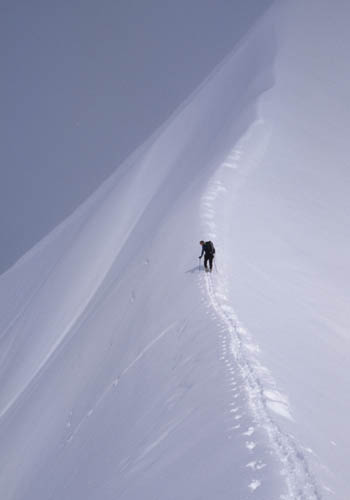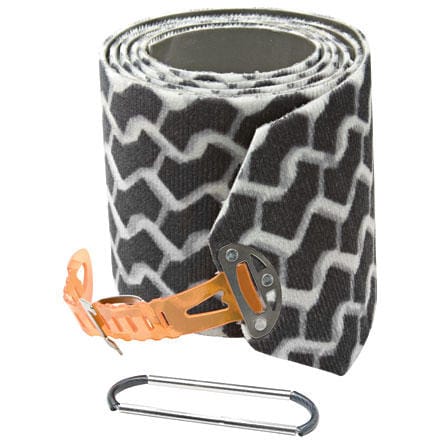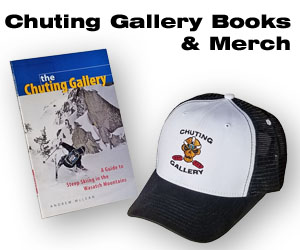Steep Skinning – Part 1
Spring is here and the time is right for skinning in your top pegs. I don’t go out of my way to always pick the steepest skin line possible, but there are times, actually, a lot of times, where a steep skin track angle is much safer, faster and more efficient.
Few things in backcountry skiing piss people off more than a steep skin track, but that is probably because they don’t know how to ascend it properly. Once you get the hang of it (details to follow in this week’s postings), setting a steep track can be way faster than wandering all over the hillside at the prescribed 12-degree perfect angle.

Lorne Glick busting out a steep one on Thunder Mountain, Alaska. This direct line hit 40 degrees in places and kept us out of avalanche starting zones.
A few steep skinning myths:
A lower angle skin track is more efficient.
Not so. Walking up a low angle handicap access ramp is technically easier step-by-step, but no more efficient than going straight up a flight of stairs. It takes a set amount of energy to climb a mountain and the variables are time and distance traveled.
The fastest racers in world all use lower angle skin tracks.
True, but that has as much to do with using bindings which only have one elevation setting and skins which glide better than they climb. The top guys/girls are also plenty speedy on steep tracks as well.
Steep tracks are set my macho jerks with something to prove.
Perhaps. Then again, maybe they are setting a steep track as an ability barrier to keep a powder stash from being overrun once the track is in. If people can’t get up, they can’t ski down. See the “no friends on a powder day” rule for further clarification.
________________________________
Help support StraightChuter.com and bust out a steep one with Black Diamond GlideLite Nylon STS Skins on sale now at Backcountry.com. Click on the photo below…
Category: 05 Uphill










Ah, zee up track is zee art. Eet eez all aboot ze up, not ze down! As an IMGAY full certified guide, I make my aspirants do poosh ups in ze snow when ze up track ees more than 15 degrees. Heil!
Irritants? How about urine on the skin track. Another trick to discourage use? Maybe I’m a prude, but after skirting numerous deep-wells of uria it makes me think twice when packing or hanging to dry. Time for rubber gloves.
The Black Diamond guys are notorious setters of steep skin tracks. May have something to do with “no friends on a powder day rule.” May also have something to do with having to get to work at a reasonable hour after dawn patrol. Either way, I’ll take poaching their track over breaking my own any day. (Thanks Ben, Paul, and other guy whose name I don’t know for the awesome track up Scottie’s this morning.)
OMR, urine is sterile. Get over it.
A lot of the time when setting a new track it does not seem that steep in the soft snow, as skins seem to grip a little better in the fresh. As tracks get packed hard and glazed with ice they become more difficult and often seem to steep. Remember, you can often step of the established track and make your own if the established one gets to steep, just throw in a extra switch back.
Your logic is about the same as mine when driving:
If I drive faster, I’ll use less gas because I get there quicker!
Skinning steep terrain is the same: You might get there quicker, but you are burning up a ton of energy!
Some food for thought!
Njord
so setting a steep track is relatively easy. FOLLOWING a steep track, especially a day or two after the last snow and a re-freeze or two–not so easy.
unless you’re going to give me tips on how to find ski crampons that fit my megawatts and somehow give enough bite when i’m in the top peg, i’m skeptical.
dug: The key is to utilize one of two extremes when following a super steep refrozen skin track.
Lead a pure and virtuous life. Pray every day to the god of your choice. Forsake all earthly pleasures such as Coffee, Scotch, Steak, and Sex, and you will float up anything.
Or
Sell your soul to the Devil and you can have all the fun you want and you will float up anything…Just be sure to read the fine print on the contract because Hell is flat and it never stops snowing.
I found this website this winter shortly before I moved out to the DC area and it has been my saving grace. I love the touring tips and seeing where you guys are going next! Thanks for keeping this lonely powder hound sane for a little while longer….
Any favorite spots back East to try out (next winter)?
Exactly dug. Once the track is glazed you’re talking a whole different situation. IMHO Andrew is correct in that a steep track can sometimes be useful, but to say it’s more efficient is not something I’m in agreement with. It’s probably nearly as efficient as a lower angled track if you have such superior technique that you’re able to stay relaxed and not tense up, but as soon as you’re working your upper body to stay balanced as you pull or push on your ski poles, that easily negates any gains in efficiency. And slip backwards and fall just once, and you can totally write off any gains.
That said, where a steep track is hugely more efficient is when breaking deep trail, as it’s simply fewer steps. But that doesn’t help the folks who come after, just the guy breaking trail.
I’ve never measured the angle of what’s most efficient for myself, but from much experimentation I know it’s not the super steep set by the hardcore chargers. And it’s not 12 degrees. Somewhere in between.
“It takes a set amount of energy to climb a mountain and the variables are time and distance traveled.”
So all routes up Denali take the same amount of energy?
I think Andrew is overstating his argument here, but in general he is correct in that many times a steeper skin track is better (especially if you’re the one setting it). Those AMGA folks who argue otherwise are just trying to kiss up to the Euros.
Another twist to the angle argument is the challenge of edging on steep hard snow. It seems to me that this a time when steeper is better, especially with modern sidecut and fatter skis. Keeping those fat skins in contact with the snow takes advantage of the strengths of the modern equipment. Old skinny skis edged great, but didn’t have 130 mm of grippy velcro to climb straight up.
The slickness of an old skin track depends on many things. Usually they are harder to follow, but not always. And even then, if you can’t follow it, you can always break a new one or follow as much of it as you can.
In general, old skin tracks can often be hard to follow, even if they are cut at a moderate angle. I don’t see any way around this, except to cut very, very low angle skin tracks with the idea that they will then be easier to follow days later, but then, why?
I agree with the gripes about glazed older tracks, but I find it easier to keep one ski in the old track while breaking a new one with the other. Bitching uses energy.
Even though I don’t agree with steep skin tracks I totally agree that they are safer way of travel in specific conditions/terrain. And I think that’s what the post was really about – safety.
So no point arguing the efficiency aspect, however, the variables are not only “time and distance traveled” but spent energy as well. Unless of course we are talking about a trip that is fairly unchallenging for a given person to do.
And thanks for all the tips Andrew.
Steep, shallow, it all gets you there sooner or later. I like them both. What I hate are poorly executed switchbacks. I’ve made ’em and felt bad. I wish that I could post a sign that just says ‘Caution, crap kickturn ahead!’
I agree with Lou’s questioning of the efficiency. I think efficiency does vary with track steepness and that it is possible to make a track at an angle where it is possible but not very efficient. I also suspect that if rando racers felt that steeper track were faster, they’d accept the weight penalty and use taller heel lifts. Or they would have their toenails removed to compensate for the extra weight.
A steep *section* of a skin track may be safer or more efficient. Consistently steep skin tracks, however, are wasted opportunities. About 75% of backcountry time is going up. That’s the time to get info about snow stability and discuss it with your partners – not on a ridge where you’re freezing in the wind, out of breath, hungry, tired & jonesing for the powder/ run. Consistently steep skin tracks make it physically difficult to look around and communicate – your head goes down and your eyes focus on a spot just in front of your tips, and you’re breathing too hard for any sort of discussion even if you were to notice anything important about the snow conditions. Moreover, a track that’s “wandering all over the hillside” is one that can sample snow conditions on a variety of aspects and slope angles. A moderately angled up-track allows you to do a huge amount of the observations and communication necessary for good decisions before you ever get to the run, without the pressures and distractions of standing right at the top of the run.
Of course, for this to be meaningful you have to care about maintaining good situational awareness and believe that good decison-making is an ongoing process through the day…..